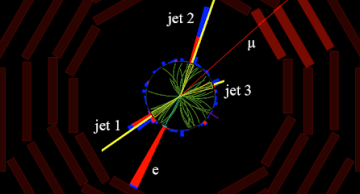Neutrinos (𝝂) are the most intriguing particles in nature. The evolution in our understanding about the characteristics of the neutrinos is also very interesting. The apparent non-conservation of energy in beta decay led Pauli to predict, in 1933, a…
Ask someone what experiments at the CERN-LHC do, they will tell you: ‘You accelerate two protons to very high energy, smash them together and look in great detail at all particles created from the disintegration of the protons.’ etcetera. Well… yes…
Press Statement
The CMS collaboration has substantially improved the precision with which the top quark mass is measured. The latest result, a measurement of the top quark mass of 171.77 ± 0.38 GeV, was presented at CERN last week and estimates the…
The quantum theory of electromagnetic interaction, called quantum electrodynamics (QED), is the most accurate and successful mathematical description of a large variety of natural phenomena. In numerous experiments over last many decades it has been…
Tau leptons are the heavy siblings of muons and electrons, being respectively 170 and 3500 times more massive. Leptons are not sensitive to strong interaction. The tau leptons are however so massive (about 1.8 times heavier than the proton) that…
CMS casts a wide net in the hunt for undiscovered particles
Physicists at the CMS experiment have been searching for new particles in exciting new places. In a recently published paper, they explore the possibility that the Large Hadron Collider (…
One of the intriguing questions in particle physics is the origin of mass of the fundamental particles. The question we ask is: is the Higgs boson responsible for the masses of all the known particles? The well-established theory of particle physics…
One of the fundamental puzzles we face today is the dark matter (the dunkle materie, as called by the Swiss physicist Fritz Zwicky back in 1933) in the universe. It is highly abundant (almost five times more than all the objects put together…
The word lepton comes from the Greek λεπτός (leptós,) meaning “small”; the electrically charged leptons (electrons, muons, and taus) have much smaller masses than their counterparts in the quark sector. For example, the tau particle is the…
Since the Higgs boson discovery in 2012 by the CMS and the ATLAS collaborations, the interaction of the Higgs boson with other fundamental particles as well as with itself are studied with ever-increasing precision to pin down the nature of this new…
The collision of high-energy protons at the LHC breaks them apart and allows us to look at its constituents. Surely there are more interesting stuff in store, compared to the usual constituents at lower energy, the up and the down type quarks.…
The Higgs boson is peculiar in many respects. Like most other elementary particles, it is unstable and lives only for an extremely short time, 1.6 x 10-22 seconds, according to the established theory of particle physics (the standard model). Pretty…












